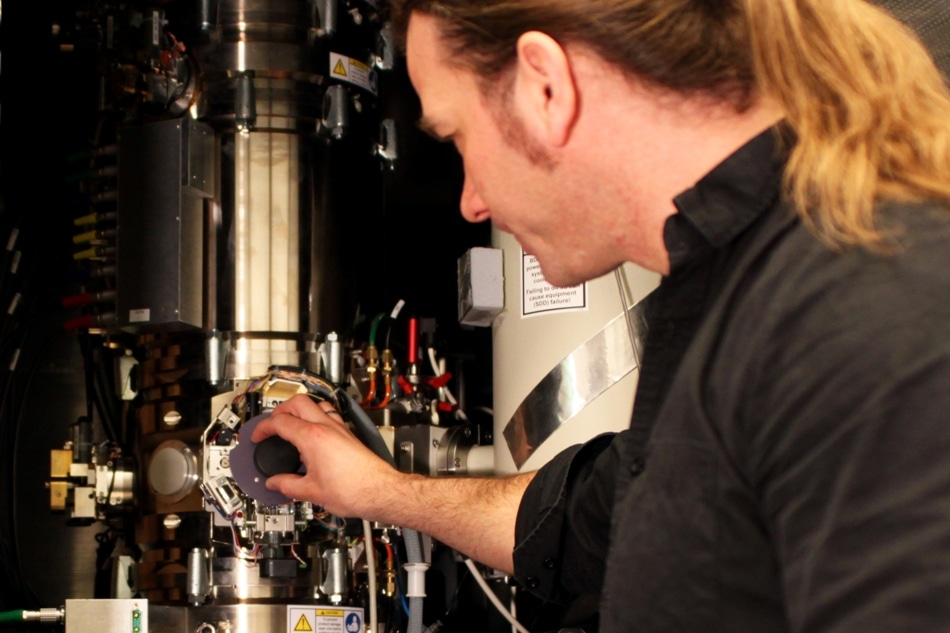May 10 2017
 (Credit: Karin Söderlund Leifler)
(Credit: Karin Söderlund Leifler)
Under certain circumstances, the movement of atoms via a material can lead to problems. With the help of atomic-resolution electron microscopy, researchers at LiU, for the very time, observed a phenomenon that has escaped from materials scientists for decades.
In a few contexts, it is extremely essential to maintain boundaries. An example for this is within thin film technology, which used very thin films of different materials piled up on each other. The thermally induced movement of atoms via a material, diffusion, has already been established. In the early 1950s, a specific sort of diffusion together with linear defects in a material was proposed, however this proposal remained a theoretical concept since then and researchers were never successful in observing it directly. As an alternative, indirect methods and theoretical models are commonly used to measure that phenomenon called dislocation-pipe diffusion.
Recently, researchers at Linköping University and the University of California in Berkeley finally succeeded in observing the migration of atoms between the layers of a thin film. These findings were then published in the Nature journal Scientific Reports. Scanning transmission electron microscopy (STEM) was used with such an extremely high resolution that it was in fact possible to image the positions of separate atoms in the material. The specimen analyzed by the researchers was a thin film in which layers of a metal, called hafnium nitride (HfN), about 5 billionths of a meter thick, alternate with layers of scandium nitride (ScN), which is a semiconductor.
The properties of the HfN/ScN layers allow this material to be considered as an ideal candidate for use in, for instance, microelectronics and coating technology. It is essential to prevent the mixing of the semiconductor and layers of metal in order to maintain stability. Problems occur when the atoms diffuse across an interlayer producing a closed bridge between the layers in the film, similar to an electric short circuit.
The material we have studied acts as a perfect model system, but this type of diffusion occurs in nearly all materials. Metals and semiconductors are found in all the electronic components used in in mobile phones, computers, etc. This is why it is important that materials scientists understand this type of diffusion.
Magnus Garbrecht, Associate Senior Lecturer, Department of Physics, Chemistry and Biology, Linköping University
Reduces strain
The discovery discussed in the article took place when HfN/ScN was heated to 950 °C by Magnus Garbrecht. Magnus Garbrecht observed that the hafnium was spreading down into the underlying layers, because of a defect in the material where this phenomenon took place. The material was heated for a number of times by the researches, and then STEM was used to examine the material. This allowed the researches to measure how far each atom moved.
The values we measured agree well with those from previous experiments using indirect methods and with the theoretical models, and this makes us confident that what we are seeing really is dislocation-pipe diffusion.
Magnus Garbrecht, Associate Senior Lecturer, Department of Physics, Chemistry and Biology, Linköping University
The researchers explained why the atoms diffuse when the material is heated. The individual atoms are to some extent displaced relative to each other in the areas around the linear defects. The atoms tend to organize themselves in a perfect cubic symmetry, resulting in the building up of strain within the lattice when this arrangement experiences a disturbance. In the study, the researchers demonstrate that this strain relaxes as diffusion of the atoms take place.
The diffusion reduces the strain in the material and this is why it only occurs along the linear defects threading through the material.
Magnus Garbrecht, Associate Senior Lecturer, Department of Physics, Chemistry and Biology, Linköping University
The thin films were grown by Magnus’ collaborator Bivas Saha at the University of California, and recently both these scientists were together awarded a research grant from the Swedish Foundation for International Cooperation in Research and Higher Education, STINT, in order to further establish their partnership. Along with other organizations, the Swedish Research Council, the Swedish government’s Strategic Research Area initiative into advanced functional materials (AFM), and the Knut and Alice Wallenberg Foundation funded the research.